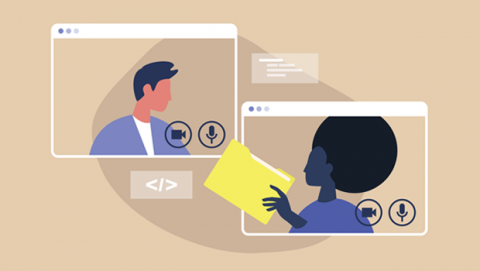To the casual observer, the rise of digital technology during the COVID-19 crisis may resemble the remarkable "overnight success" of an athlete who makes a well-timed play during a crucial playoff game, or an actor who steps into a leading role on opening night. Of course, the success of the athlete and actor doesn’t truly happen overnight: It’s the culmination of years of preparation and hard work that enables them to succeed when opportunity calls.
As I reflect on the past five months, I would make the case the same is true for the recent adoption of digital technology: The dramatic constraints of the COVID-19 crisis may have been an unprecedented opportunity to show the potential of digital transformation to enhance the customer and employee experience.
Yet at Lincoln Financial, it’s been four years of thoughtful planning and strategic investment that have allowed us to achieve record digital adoption and acceleration of our strategy in this crucial moment.
At Lincoln, we’ve been committed to transforming a century-plus-old, Fortune 200 company to compete and lead in a rapidly changing, digital-driven environment. We’ve been focused on developing, launching and promoting better, frictionless experiences for both our employees and external customers.
In March, we pivoted 99 percent of our employees to a work-from-home environment in just a matter of days in response to COVID-19. Logistically, this was an adjustment for many of us, but one that went smoothly thanks to business continuity planning and digital investments we had already made.
[ Get your digital transformation priorities in order. Read also: Digital transformation: How to keep moving in tough times. ]
During the last four years, we had been working to increase our digital capabilities and provide the infrastructure that allowed us to quickly shift to a work-from-home model. Investments in a secure network for virtual connectivity, portable computing and collaboration tools were all foundational to our successful pivot. We made a big push to ensure we had stability in the initial days and bulked up our tech support to anticipate our employees’ needs as they transitioned to work from home. And of course, mitigating our security risk and protecting our assets was foundational across our efforts.
Seizing the chance to encourage digital adoption
After the pivot, our data showed we were running the company effectively in this new way. This allowed us to shift our focus to optimizing the environment that we were operating in. Our first focus was on improving the use of our digital and collaboration tools. We wanted to drive assurance that our employees and partners were informed on everything that was available to them and how they could best use the tools at their disposal.
CIOs are well-versed in the challenges of IT tool and software adoption. It’s especially challenging in a long-standing industry that historically relies on lengthy, in-person, paper-driven processes, such as life insurance. And while we were working with partners and stakeholders throughout the organization to help increase adoption of our tooling before the pandemic, the rapid shift to remote work had a positive side effect on our efforts.
We used this new level playing field – again 99 percent of our employees along with the bulk of our financial professional partners and customers were now working from home – to bolster adoption for our collaboration tools and digital capabilities.
For example, before the pandemic, Lincoln wholesalers and financial professionals would primarily interact with customers through face-to-face, in-person meetings with individuals or small groups of people. To support the transition to a virtual meeting environment, we teamed up with our distribution organization to empower our wholesalers to effectively use the collaboration tools that had been put in place so they could continue to conduct business and serve clients.
This included spinning up a digital toolkit to help them establish a digital presence through virtual meetings, virtual schedulers, social media and more. No longer would meetings be determined by the physical route – as wholesalers gained comfort with their new digital environment, they began to collaborate with their partners in new, more responsive cadences.
We also focused on helping our employees as they transitioned by offering support and resources (videos, blogs, guides) on how to best use collaboration tools, such as WebEx and Teams, to foster greater, faster collaboration across teams. We received feedback that 82 percent of our employees felt they were as productive – if not more – in this work-from-home environment as they were in the office. And 88 percent of employees indicated they’re comfortable using the new collaboration technology.
Another silver lining from the pandemic was seeing the adoption of our digital capabilities accelerate within a matter of days. We invested a lot of resources toward advancing our foundational digital capabilities, including establishing a digital adoption center of enablement to instill and support results-driven adoption practices using data and metrics. However, despite our laser-focus, up until the COVID-19 crisis, gaining adoption continued to be a challenge.
For example, in our life insurance business, applications were traditionally completed on paper due to the in-person nature of our work. With the pandemic, things had to shift. As financial professionals and customers across the country were faced with "stay-in-place guidelines," we needed to empower financial professionals to continue to help clients secure the coverage they needed from the safety of their home with a frictionless experience. This meant pivoting to the digital options available, such as online applications, e-signature, digital policy delivery and statements-on-demand.
We saw a big uptick in adoption of our digital submission options, including our mobile-enabled electronic application and our abbreviated electronic questionnaire. For Lincoln, 70 percent of our new life applications flow through electronically now, an increase of 25 percent since January.
[ Get answers to key digital transformation questions and lessons from top CIOs: Download our digital transformation cheat sheet. ]
Another area in which we’re seeing success moving away from the traditional method is in the delivery of life insurance policies. Traditionally, we used to print, bind, and mail paper copies to policyholders. Now, 100 percent of Lincoln’s life insurance policies are delivered electronically, double since the start of the year.
We leaned into our strategy and leveraged our multi-year, digital investments to meet our customers where they needed to be met in the COVID-19 environment. In some industries – insurance, included – it takes an event to drive this level of adoption. The pandemic did that for us.
Sustaining the momentum
One of our challenges is figuring out how to sustain the momentum we’ve experienced. We want to make sure we don't fall back in the areas where we’ve forged so strongly ahead – in the high adoption of tools and the capabilities we've built and delivered. We want to continue our push to modernize our business and operations in an industry that's very traditional.
One way we’re doing this is by acknowledging the potential for opportunity.
CIOs across the board should be looking at not only their pre-pandemic plans – which, in our case, was driving a digital program – but also looking at the new possibilities that have emerged from such a dramatic shift. For example, in the absence of in-person engagements and observations, organizations will need to rely more heavily on data for decision-making purposes. We have to recognize that business will be conducted differently going forward.
CIOs have a big opportunity now to to promote a test-and-learn mindset. People are currently much more open, and in some cases, forced to experiment and innovate due to the changing circumstances.
We know, for example, that our wholesalers and teams that visit client offices for presentations won't be visiting those offices in the same way. Our videoconferencing capability, however, allows wholesalers to continue those conversations virtually and often, more efficiently. Benefits include eliminating travel time as well as the ability to host more clients virtually compared to in-person programs with limited capacity. While we could go back to those in-person meetings, we’ve discovered additional avenues to conduct business.
Our digital investments have proven to be effective and efficient, which is making it easier to do business with us and creating a frictionless, customer-centric experience. We want our customers, employees and partners to view Lincoln as a company that continues to evolve and innovate to deliver on our purpose – provide financial peace of mind to everyday consumers across the United States.
[ Culture change is the hardest part of digital transformation. Get the digital transformation eBook: Teaching an elephant to dance. ]







Comments
Enhancing the employee and customer experience is a focus that should be at the top of all CIOs’ priority list today. Having the appropriate digital tools to provide the infrastructure a team needs to quickly shift from one environment to another is how an enterprise stays strong through times of turbulence. This eBook speaks directly to the CIO about what initiatives should be prioritised in order to stay competitive and agile today. Have a read.
https://www.redwood.com/resource/top-priorities-for-cios-part-one?utm_source=linkedin&utm_medium=organicsocial&utm_campaign=unlock_potential